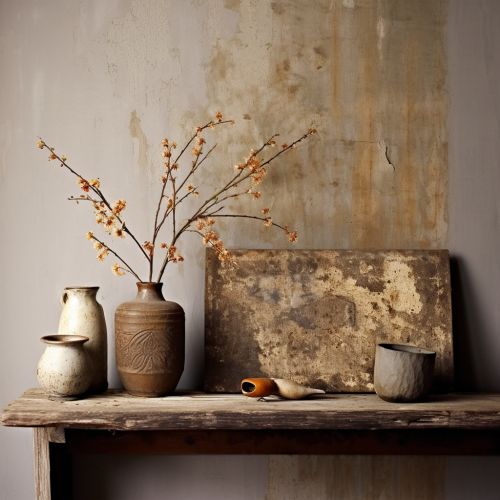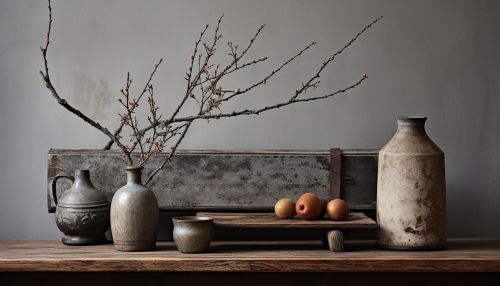Wabi-sabi
Overview
Wabi-sabi is a concept in traditional Japanese aesthetics that finds beauty in imperfection, impermanence, and incompleteness. It is derived from the Buddhist teachings about the three marks of existence, specifically impermanence, suffering, and non-self.


Origins and Etymology
The term wabi-sabi is a combination of two words, both of which have evolved in meaning over time. The word 'wabi' originally referred to the loneliness of living in nature, away from society, but has since come to mean rustic simplicity, freshness, or quietness. It can also refer to quirks and anomalies that add uniqueness and elegance to an object. 'Sabi', on the other hand, originally meant 'chill', 'lean', or 'withered', but has evolved to mean the beauty or serenity that comes with age, when the life of the object and its impermanence are evidenced in its patina and wear, or in any visible repairs.
Principles
Wabi-sabi is underpinned by several principles, including:
- Kanso (Simplicity): Simplicity is at the heart of wabi-sabi. It is about eliminating all non-essential elements and appreciating the inherent beauty of simplicity.
- Fukinsei (Asymmetry, Irregularity): Wabi-sabi embraces irregularity as a state of nature. It rejects the concept of perfect symmetry and instead appreciates the balance provided by uneven elements.
- Shibumi (Elegance): This principle refers to beauty in understated and subtle details. It is elegance that is not flashy or obvious, but quietly awe-inspiring.
- Shizen (Naturalness): Wabi-sabi is about accepting things as they are without artificiality or pretense. It appreciates the natural state of all things.
- Yugen (Subtlety): This principle refers to the profound grace and subtle mystery of the universe. It values the details that are not visible to the naked eye.
- Datsuzoku (Freedom): Wabi-sabi values the freedom from habit and formula. It appreciates the unexpected and unbounded.
- Seijaku (Tranquility): In the hustle and bustle of life, wabi-sabi finds tranquility and peace in silence and solitude.
Wabi-sabi in Art and Design
Wabi-sabi has significantly influenced Japanese art and design. It is seen in various art forms such as ikebana (flower arranging), tea ceremony, garden design, and pottery. The concept is also reflected in Japanese architecture and interior design, where it manifests as minimalist spaces that highlight the natural beauty of materials, as well as in the use of imperfect and irregular shapes and forms.
Wabi-sabi in Western Culture
In recent years, the concept of wabi-sabi has also found resonance in Western culture, particularly in the world of design. It has inspired a movement away from mass-produced perfection towards handmade objects that bear the marks of their maker. This can be seen in various fields, from interior design and architecture to fashion and food.
